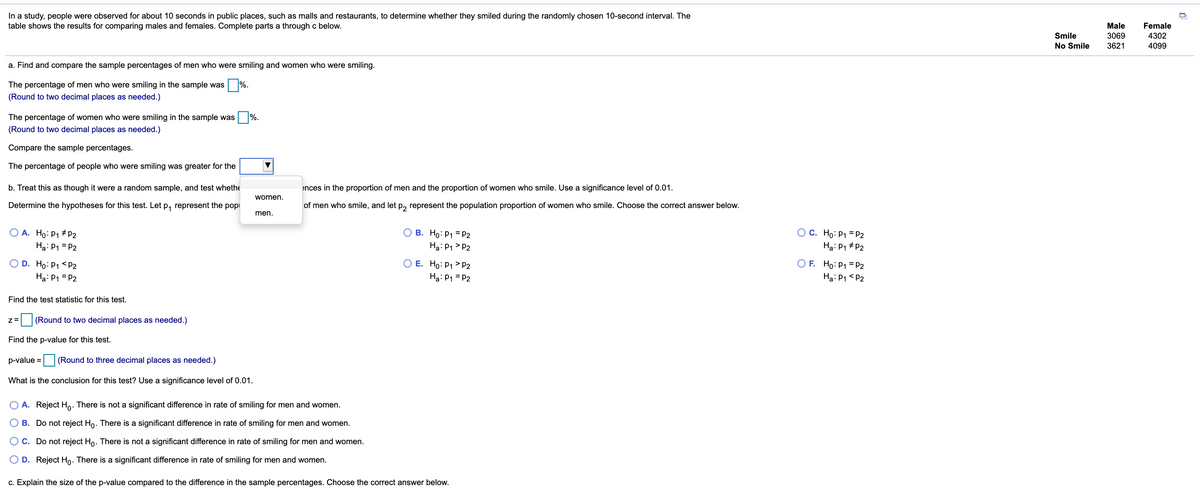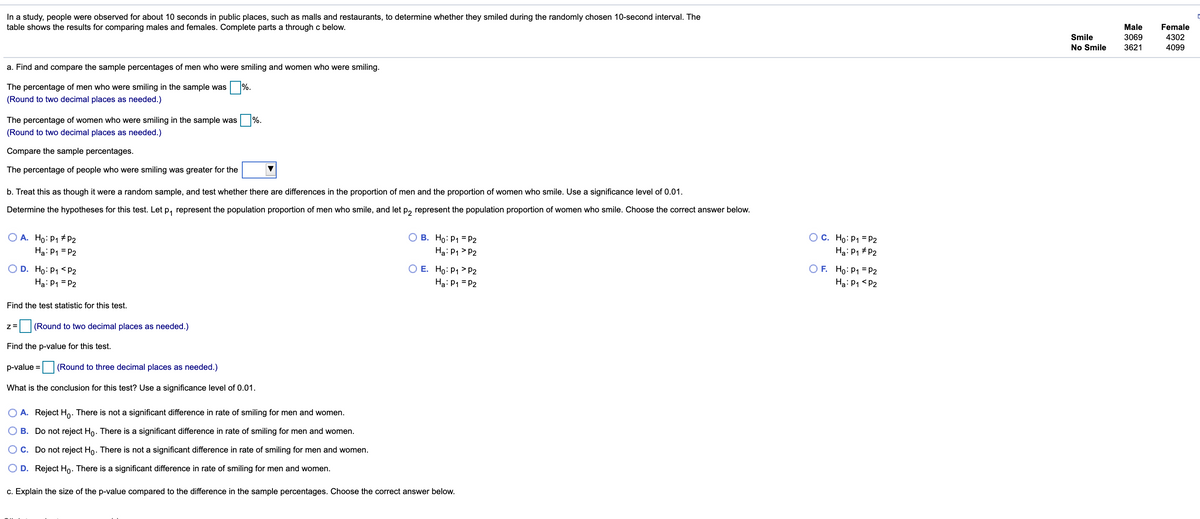Help, please.
Algebra & Trigonometry with Analytic Geometry
13th Edition
ISBN:9781133382119
Author:Swokowski
Publisher:Swokowski
Chapter7: Analytic Trigonometry
Section7.2: Trigonometric Equations
Problem 100E
Related questions
Topic Video
Question
Help, please.

Transcribed Image Text:In a study, people were observed for about 10 seconds in public places, such as malls and restaurants, to determine whether they smiled during the randomly chosen 10-second interval. The
table shows the results for comparing males and females. Complete parts a through c below.
Male
Female
Smile
3069
4302
No Smile
3621
4099
a. Find and compare the sample percentages of men who were smiling and women who were smiling.
The percentage of men who were smiling in the sample was %.
(Round to two decimal places as needed.)
The percentage of women who were smiling in the sample was
%.
(Round to two decimal places as needed.)
Compare the sample percentages.
The percentage of people who were smiling was greater for the
b. Treat this as though it were a random sample, and test whethe
ences in the proportion of men and the proportion of women who smile. Use a significance level of 0.01.
women.
Determine the hypotheses for this test. Let p, represent the popi
of men who smile, and let p, represent the population proportion of women who smile. Choose the correct answer below.
men.
O A. Ho: P1 # P2
Ha: P1 = P2
O C. Ho: P1 = P2
Hạ: P1 + P2
B. Ho: P1 = P2
Ha: P1 > P2
O E. Ho: P1 > P2
O D. Ho: P1 <P2
Ha: P1 = P2
O F. Ho: P1 = P2
Ha: P1 <P2
Ha: P1 = P2
Find the test statistic for this test.
z=
(Round to two decimal places as needed.)
Find the p-value for this test.
p-value =
(Round to three decimal places as needed.)
What is the conclusion for this test? Use a significance level of 0.01.
A. Reject Ho: There is not a significant difference in rate of smiling for men and women.
B. Do not reject Ho. There is a significant difference in rate of smiling for men and women.
C. Do not reject Ho. There is not a significant difference in rate of smiling for men and women.
D. Reject Ho. There is a significant difference in rate of smiling for men and women.
c. Explain the size of the p-value compared to the difference in the sample percentages. Choose the correct answer below.

Transcribed Image Text:In a study, people were observed for about 10 seconds in public places, such as malls and restaurants, to determine whether they smiled during the randomly chosen 10-second interval. The
table shows the results for comparing males and females. Complete parts a through c below.
Male
Female
Smile
3069
4302
No Smile
3621
4099
a. Find and compare the sample percentages of men who were smiling and women who were smiling.
The percentage of men who were smiling in the sample was %.
(Round to two decimal places as needed.)
The percentage of women who were smiling in the sample was
%.
(Round to two decimal places as needed.)
Compare the sample percentages.
The percentage of people who were smiling was greater for the
b. Treat this as though it were a random sample, and test whether there are differences in the proportion of men and the proportion of women who smile. Use a significance level of 0.01.
Determine the hypotheses for this test. Let p, represent the population proportion of men who smile, and let p, represent the population proportion of women who smile. Choose the correct answer below.
O A. Ho: P1 # P2
Ha: P1 = P2
O B. Ho: P1 = P2
Ha: P1 > P2
O C. Ho:P1 = P2
Hạ: P1 # P2
O D. Ho: P1 <P2
Ha: P1 = P2
O E. Ho: P1 > P2
Ha: P1 = P2
O F. Ho: P1 = P2
Ha: P1 <P2
Find the test statistic for this test.
(Round to two decimal places as needed.)
Find the p-value for this test.
p-value = (Round to three decimal places as needed.)
What is the conclusion for this test? Use a significance level of 0.01.
O A. Reject Ho. There is not a significant difference in rate of smiling for men and women.
O B. Do not reject Ho. There is a significant difference in rate of smiling for men and women.
O C. Do not reject Ho. There is not a significant difference in rate of smiling for men and women.
O D. Reject Ho. There is a significant difference
rate of smiling for men and women.
c. Explain the size of the p-value compared to the difference in the sample percentages. Choose the correct answer below.
Expert Solution
This question has been solved!
Explore an expertly crafted, step-by-step solution for a thorough understanding of key concepts.
Step by step
Solved in 4 steps with 4 images

Knowledge Booster
Learn more about
Need a deep-dive on the concept behind this application? Look no further. Learn more about this topic, statistics and related others by exploring similar questions and additional content below.Recommended textbooks for you

Algebra & Trigonometry with Analytic Geometry
Algebra
ISBN:
9781133382119
Author:
Swokowski
Publisher:
Cengage

Trigonometry (MindTap Course List)
Trigonometry
ISBN:
9781305652224
Author:
Charles P. McKeague, Mark D. Turner
Publisher:
Cengage Learning

Linear Algebra: A Modern Introduction
Algebra
ISBN:
9781285463247
Author:
David Poole
Publisher:
Cengage Learning

Algebra & Trigonometry with Analytic Geometry
Algebra
ISBN:
9781133382119
Author:
Swokowski
Publisher:
Cengage

Trigonometry (MindTap Course List)
Trigonometry
ISBN:
9781305652224
Author:
Charles P. McKeague, Mark D. Turner
Publisher:
Cengage Learning

Linear Algebra: A Modern Introduction
Algebra
ISBN:
9781285463247
Author:
David Poole
Publisher:
Cengage Learning